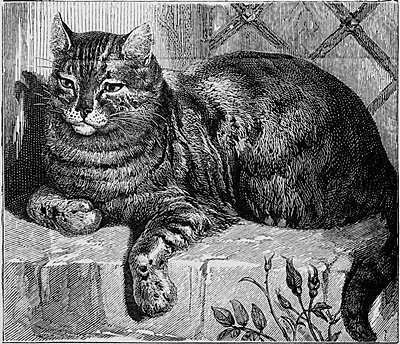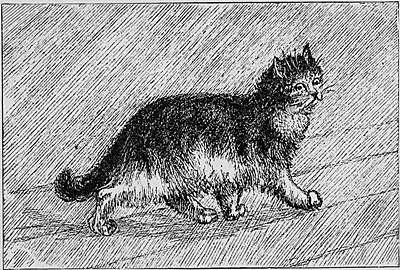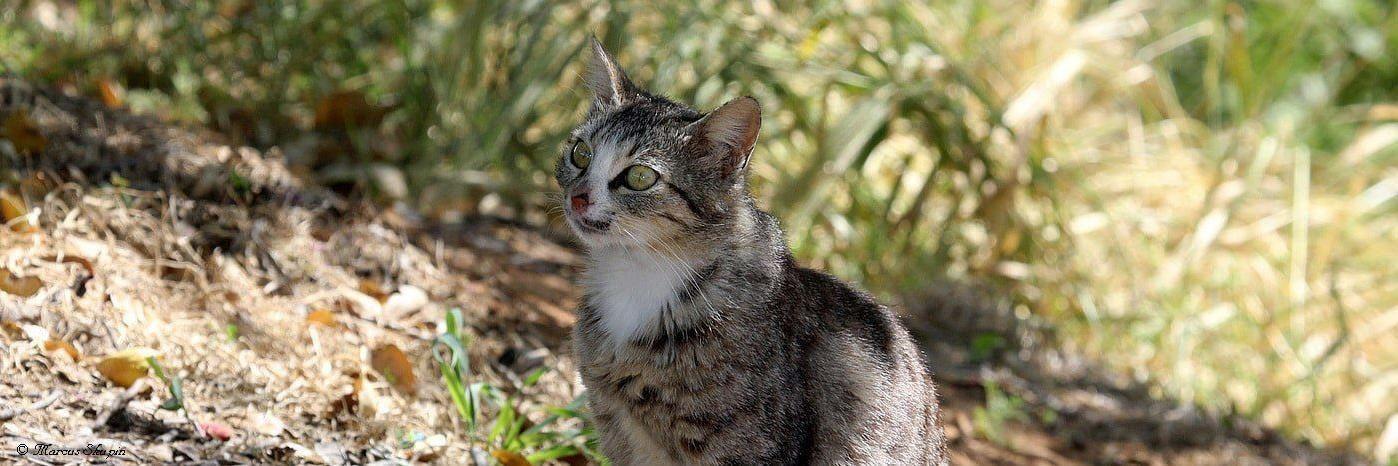Chapter 5
Chapter V
DOMESTIC VARIETIES.
In the estimation of persons who have no appreciation of the beautiful in animal life, a cat is a cat, and nothing but a cat. I have often observed some surprise expressed by visitors at a large cat-show on seeing an assemblage of so many different sorts of cats. These same persons had often seen examples of every class before in the houses of friends, in shops, gardens, etc., etc.; but the beauties had been passed unobserved. At a good show, where well-selected specimens of the common house cat are arranged in line, and classed according to colour, sex, etc., a novice cannot but be surprised at the unexpected sight of so interesting an array of feline beauty. At the leading shows the animals are arranged in two main divisions; viz., long-haired and short-haired cats. These two divisions are again sub-divided into he-cats, she-cats, kittens, and gelded cats. The he and she-cats are again divided in classes according to colour, as tortoiseshell and tortoiseshell and white, brown, blue or silver, and red tabby, tabby and white, and spotted tabby; also cats of unusual colour, and Manx, or tailless cats. A brief description of the characteristic points of the different classes, as at the Crystal Palace, will be given in this chapter.
The 13th of July, 1871, was a memorable day in the cat world, and an eventful one at the Crystal Palace, for it was then and there that the very first cat-show took place. Mr. Harrison Weir, F.R.H.S., the well-known animal painter, has the honour of being the originator of these interesting exhibitions; and he has kindly placed at my disposal a few particulars respecting the primary arrangements. He suggested the idea to Mr. Isaac Wilkinson, manager at that time, drew up the schedule of prizes, the way in which the classes were to be judged, the amount of prize-money, etc.; and he also acted as judge. The show was put under the management of Mr. Wilson, of the Natural History Department, who very ably conducted it; and the whole affair proved a gratifying success so much so, that Mr. Weir received the thanks of the Directors, and a very handsome, large silver tankard, with suitable inscription. So great a success did the exhibition prove, that it was immediately decided to repeat it later in the year.[2] The show was also held twice in the year following (1872), and has been continued annually ever since. "My idea, Mr. Weir remarks, "for holding a show was that the cat was a truly useful domestic animal, though a much neglected one, and if I could only induce the multitude to take a pride in their cats, and select them more for their beauty and ultimate value in the market, I might achieve a good result in the way of kindly treatment to an animal much neglected by some.
The great success and the good example of the Crystal Palace show was very naturally soon followed up at Edinburgh, Birmingham, Glasgow, and many large centres of population, and now even the smaller provincial towns can boast an annual exhibition of feline favourites.
The varieties of our short-haired cat will now deserve our attention.
Tortoiseshell. Cats of this breed are also sometimes called Spanish cats, and display a very marked contrast to the tabby varieties. The general colour is a kind of reddish tawny, or sandy, more or less thickly covered with blotches or dabs of black. So very irregular are the markings in these cats, that some individuals are very handsome creatures, and some, on the other hand, are far from prepossessing in appearance. Tortoiseshell cats are of somewhat smaller growth. But, in our comparative estimate of size, we are apt to be somewhat misguided, from the fact that all the tortoiseshell cats we meet with are she-cats, and can never attain the large size of the tom tabby cats, with which they are often compared. The tortoiseshell male cat is a treasure often sought for, but very, very seldom found. Ever since the commencement of the shows just alluded to, there has been only a single specimen of the pure tortoiseshell male cat exhibited. Experiments have been tried in every way to breed to this colour, but without the desired result. But tortoiseshell and white he-cats are occasionally to be seen. At the last Crystal Palace show there were two very fine toms of this description.
Our common favourites, the tabby cats, are, on the whole, the handsomest and the best. They are of every shade, but three distinct varieties are known as brown, blue or silver, and red.

Tabby cat
Brown Tabby. Although there is considerable individual variation in these cats, the general characteristics are as follows: The ground-colour should be a deep, rich brown grey, striped with black. These markings converge from a central stripe of black, more or less broken, which follows the line of the spine, a mark in some degree characteristic of the whole feline race. The tail is barred with black, and a line of narrow stripes runs from the forehead, passes between the ears, and, passing down the neck, it disappears. The face is adorned with little swirls and stripes, so disposed as to give the general expression of the countenance that air of satisfaction so peculiar to puss. The under parts of the body may be of a paler colour, but no pure white is seen in a true tabby tom-cat. The tip of the nose, the lips, and the pads of the paws are to be desired of a dark colour. One, if not two, bold swirls of black across the chest are to be looked for in these cats. They have been appropriately termed "the Lord Mayor"s chain. These tabby cats are generally large, portly animals, if properly reared, very intelligent, and often most affectionate. The females are most gentle, and the best of mothers.
Blue or Silver Tabby. This is a pale variety of tabby, which is sometimes beautiful. The ground-colour is a silver grey, with the stripes of a darker shade.
Red Tabby. In bold contrast with the blue, these fine cats are of a bright sandy yellow, with the usual markings of a deeper shade. Some of these cats are of very good colour, so much so as to be distinguished by their proud owners under the very aspiring title of "Orange Tabby. These cats, in the main points, are like the brown tabby. The fur should be short, but full and thick, the ears rather short and round. In the tabby breeds the female is seldom without white, which generally appears upon the muzzle, throat, paws, etc. This is, most remarkably, a characteristic in the red tabby cats, a female of that colour without white being almost as rare a zoological curiosity as the wonderful tortoiseshell tom.
Spotted Tabby cats are distinguished from the others by having, instead of the usual stripes or cloudings, a pattern of quite a distinct type. The markings are broken up into small, well-defined spots, being more or less elongated upon the sides, transversely to the stripes along the back.
In the class of spotted tabby he-cats at the Crystal Palace there might have been seen a specimen named "Coppa, which was justly awarded first prize. The owner of this cat, Mr. J. Scott, has kindly favoured me with the history of Coppa, which is of some interest when regarded zoologically. The father of Coppa was a leopard-cat (Felis Bengalensis), picked up at an East Indian coffee plantation, and brought to England by a gentleman, who handed it over to Mr. Scott. He kept it for two years, and bred ten kittens by two mothers. Coppa is one of these kittens. As his mother was an English tabby, and as the pedigree of the sire is so unmistakably pure, and of the spotted kind, it is not surprising that he was the model of a spotted tabby.
It will not be out of place here to give a brief description of the leopard-cat, as delineated in "Cassell"s Natural History.
"This is another of the numerous Indian cats, and is a very beautiful species. Its hide is of a yellowish grey, or bright tawny hue, quite white below, and marked with longitudinal stripes on the head, shoulders, and back, and with large irregular spots on the sides, which become rounded towards the belly. The tail is a spotted colour, indistinctly ringed towards the tip. The body, from the end of the snout to the tip of the tail, attains a length of from thirty-five to thirty-nine inches, eleven or twelve of which are made up by the tail.
"The leopard-cat is found throughout the hilly region of India, from the Himalayas to the extreme south, and Ceylon, and in richly wooded districts, at a low elevation occasionally, or when heavy jungle grass is abundant, mixed with forest and brushwood. It ascends the Himalayas to a considerable elevation, and is said by Hodgson even to occur in Tibet, and is found at the level of the sea in the Bengal Sunderbunds. It extends through Assam, Burmah, the Malayan peninsula to the islands of Java and Sumatra, at all events. It is as fierce as any of its savage kin.
Mr. Scott sold his leopard-cat to the Zoological Society, and also presented with it the mother of Coppa and one kitten. But they unfortunately took a form of distemper, and all died, and other cats by the side of them. Coppa, Mr. Scott remarks, is probably the only one left.
Mr. Scott also remarks that he keeps Coppa confined, for fear of losing him. He was marked as dangerous at the show, on account of his pedigree, but is really "perfectly tame and very fond. I judged so myself from his appearance and manner. He did, certainly, spit at a lady who blew in his face; but any good cat, with a spark of self-respect, would do so.
Black. These fine cats are not so commonly met with, of entire colour, as the brown tabbies, but are more plentiful than either the red or the blue. This colour is probably never met with in any of the wild cats, and would, I am inclined to think, be rare in the domestic races but for a prevailing superstitious notion, to be met with even in our enlightened age, that in some way good fortune or luck attends the homestead where a black cat dwells. And, moreover, that to destroy a black cat, or even a black kitten, from the purest motive, is an act likely to be followed by some misfortune. May I be allowed to endeavour to dispel this notion from the mind of any reader who may cherish a vestige of belief in the old charms of witchcraft, by boldly asserting that the black cat is simply a tabby. In some black cats, and commonly in black kittens, the tabby character of the fur may be distinctly seen. Black leopards and jaguars are occasionally, but rarely, to be met with; and this natural melanizm has been attributed to a larger proportion of iron in the blood. There is more iron in the blood of negroes, it is said, than in that of Europeans. Now, in these black leopards the distinctive pardine livery of the species is always present, and visible upon minute inspection. "Can the Ethiopian change his skin, or the leopard his spots? (Jer. xiii. 23). Likewise, in our black cats, although not visible, the normal tendency of the species to maintain and reproduce its characteristic livery is inherent in the blood.
The black cat, like the black leopard, if well bred and properly reared, is a most perfect specimen of its kind, having all the powers and instincts of his nature most strongly developed. When in good health and properly managed, and not shut out of doors at night, the black cat is generally a splendid creature, with a coat like satin for lustre.
White. In bold contrast to the black cat is the white. Albinos, or abnormally colourless animals, are generally deficient in strength of constitution. It is owing to this fact that white cats are often more or less deaf. In selecting a kitten, I would never choose a white one. There is something very charming about a snow-white kitten, but, when it becomes a cat, expect disappointment, more especially if in or near London, or some large town, where its purity is sure to be sullied by fog or smoke. It will, moreover, probably become dull and listless, and more liable to colds and other ailments than its more robust relatives.
Manx cats, as is well known, are remarkable for having no tail, or rather, only a very rudimentary tail. The breed is curious, and it is doubtless on that account alone that it is preserved. In other respects these cats are like the ordinary animals.
Siamese. The handsome royal cat of Siam is at present but rare in this country, and is worthy of careful preservation as a breed. It is a curious cat, of one colour, a clear tawny or buff, with the exception of the muzzle, face, ears, and feet, which are black; and the fur is short, but thick and sleek. It is a cat of average size, and of compact build. At first glance it almost suggests to the mind the figure of a pug dog.
Cats are occasionally met with, in the unusual variety class at shows, of very extraordinary colour, as slate colour, uniform grey, or mouse colour, brown, tawny, etc. Such as these may be regarded as simply unfinished tabby cats if I may be allowed to use the convenient expression. And, occasionally, cats may be seen with six claws.

long haired cat
Long-haired cats, as Angola (or Angora) and Persian. These cats, especially the Angola, are sometimes very fine animals. The hair is very long and silky, forming a thick mane upon the neck and upon the cheeks, and hangs from the sides in a manner which somewhat reminds one of the musk ox. The long tail is likewise pendant with long, silken hair, and when in good order looks very handsome. A good cat of the kind seems almost aware of its own beauty; and we know that puss has the universal reputation of being proud. But these cats require care and a good home. If neglected, exposed, or ill-treated, no animals sooner degenerate. They are, moreover, disposed to become lazy and listless, and, although fashionable in a drawing-room, are not such pleasing companions, or of the same utility as mousers, as are the sleek, agile, graceful, and intelligent animals with which we are more familiar.
Gelded cats often grow very large, and, if properly kept, sometimes live to a great age. They make good, sociable pets, are not inclined to play truant, and they do not smell. The process is not a painful one if properly performed, and an animal thus treated will escape the temptation to stray or to combat with his fellows. At the age of six months, or even a little earlier, is the time at which a kitten should be sent to the veterinary surgeon. But on no account whatever must the operation be attempted upon an animal of more advanced growth. As I have just intimated, one advantage gained is that it will not secrete and eject that characteristic fluid, the pungent odour of which is well known, and is, to some persons, very offensive.

